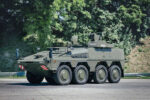The French Air and Space Force (Armée de l’Air et de l’Espace) has officially inducted the Rafale F4.2 into operational service as of October 2025. This latest evolution of Dassault Aviation’s multirole fighter introduces a suite of network-centric warfare capabilities including collaborative combat features and enhanced connectivity with other platforms. The upgrade marks a pivotal step toward the Future Combat Air System (FCAS) vision and cements the Rafale’s relevance in high-intensity peer conflict scenarios.
F4.2 Standard: Bridging Legacy Fighters to Next-Gen Warfare
The Rafale F4 program is being rolled out in two phases—F4.1 and F4.2—with the latter representing a more substantial leap in digitalization and connectivity. While F4.1 focused on improved radar modes for the RBE2 AESA radar, helmet-mounted sight integration (Scorpion), and upgraded electronic warfare (EW) suites, the F4.2 configuration introduces collaborative combat capabilities designed to operate in contested multi-domain environments.
Key enhancements under the F4.2 standard include:
- Advanced data fusion across multiple onboard sensors
- Integration of new secure communication protocols compatible with Link 16/22 and SATCOM
- AI-assisted decision support systems for real-time threat evaluation
- Collaborative engagement logic enabling manned-unmanned teaming (MUM-T)
- Open architecture for future software-defined upgrades
This positions the Rafale not just as a sensor-shooter platform but as a battlefield node capable of orchestrating joint effects across air, land, sea, and cyber domains.
Collaborative Combat: From Concept to Capability
The centerpiece of the F4.2 upgrade is its collaborative combat functionality—a capability that enables real-time data sharing between multiple fighters and unmanned systems via secure tactical datalinks like Link 16 or proprietary French protocols such as CONTACT radio waveforms.
This allows Rafales to operate as part of a distributed sensor-effector web where one aircraft can detect a target while another engages it—leveraging line-of-sight constraints or survivability considerations. It also facilitates dynamic retasking during missions without centralized command intervention.
The system builds upon France’s broader C3/C4ISR modernization efforts under programs like SCCOA (Système de Commandement et de Conduite des Opérations Aériennes). Dassault has also confirmed that these capabilities are being validated through live-fly exercises involving drones such as nEUROn UCAV demonstrators and surrogate UAVs operated by DGA Essais en vol.
AI-Enabled Mission Systems and Sensor Fusion
The Rafale F4.2 leverages artificial intelligence modules embedded into its mission computer suite to assist pilots in high-cognitive-load scenarios such as dense EW environments or time-sensitive targeting chains.
These AI tools support:
- Automated threat prioritization based on radar/IR/ELINT inputs
- Semi-autonomous target recognition using EO/IR imagery
- Predictive maintenance diagnostics using onboard health monitoring data
This AI integration is aligned with France’s SCAF/FCAS ambitions where human-machine teaming will be central to future airpower concepts involving optionally crewed wingmen (“Remote Carriers”) operating alongside manned fighters like the New Generation Fighter (NGF).
Industrial Partners and Program Timeline
The Rafale F4 standard is being developed by Dassault Aviation in collaboration with Thales (avionics/sensors), Safran (engines), MBDA (weapons integration), Airbus Defence & Space (connectivity), and DGA (Direction Générale de l’Armement). The program was greenlit by France’s Ministry of Armed Forces in January 2019 with an initial €1.9 billion investment for development through mid-2020s.
The first batch of production-standard Rafales upgraded to F4 began delivery in early 2023 under the F4.1 configuration; flight testing for F4.2 was conducted throughout late 2023–mid-2025 at Istres-Le Tubé Air Base by DGA Flight Test Center.
Export Implications: A Competitive Edge for Dassault?
Dassault Aviation has positioned the Rafale F4 standard as a key differentiator in export competitions against rivals like Eurofighter Typhoon Tranche 4+, Saab Gripen E/F, or even U.S.-made platforms like the latest Block III Super Hornet or upgraded F-16V Viper.
Countries such as India—already operating Rafales—are closely watching these developments amid discussions around potential local production lines under its Multi-Role Fighter Aircraft (MRFA) program. Indonesia’s order for 42 jets may also see deliveries configured to at least partial-F4 standards depending on contract finalization timelines.
Toward FCAS Integration and Future Growth Pathways
The operationalization of Rafale F4.2 serves not only immediate force projection needs but also lays critical groundwork for France’s participation in FCAS—a trilateral program between France, Germany, and Spain aimed at fielding a sixth-generation air combat system by ~2040s.
The modular open architecture adopted under F4 will facilitate smoother transition paths toward NGWS components including Remote Carriers, cloud-based battle management systems (“Combat Cloud”), cognitive EW suites, and quantum-secure communications—all hallmarks of FCAS doctrine.
Next Steps: Toward Rafale “F5”?
Dassault has already begun preliminary studies on an “F5” standard expected post-2030 which may integrate stealthier design elements via conformal coatings or shaping modifications; deeper MUM-T capabilities; hypersonic weapon compatibility; swarm drone control; and potentially hybrid-electric propulsion subsystems if technology maturity permits.
Conclusion: A Future-Proof Multirole Platform?
The induction of Rafale F4.2 into frontline service marks more than just another software update—it represents France’s commitment to maintaining technological parity against peer adversaries through incremental but meaningful capability insertions into legacy platforms.
If successfully integrated across all squadrons by late this decade—as planned—the French Air Force will possess one of Europe’s most digitally connected fighter fleets capable of operating seamlessly within NATO networks while preparing domestically for next-gen sovereign airpower constructs under FCAS.










